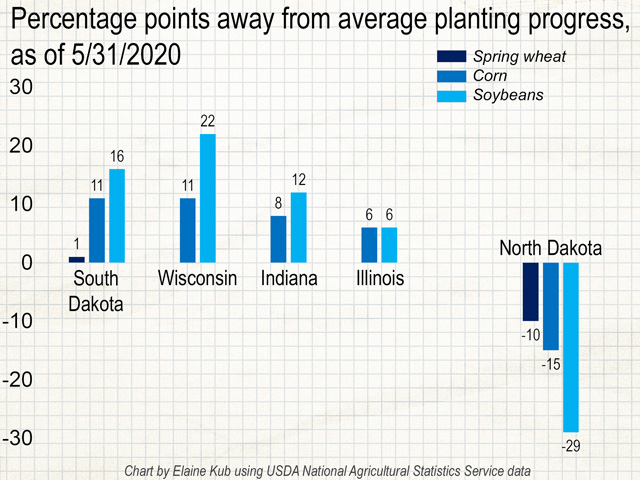Kub's Den
The Haves and the Have Nots
Consider this your regularly scheduled reminder that all is not well in the farm fields of North Dakota and hasn't been for quite some time. Recall that grain producers across most of the Corn Belt struggled to harvest corn and soybeans last fall amid persistent rain, but that North Dakota farmers ultimately had to leave millions of acres of corn unpicked and standing through the winter. Their 2019 planting was late or outright prevented; their summer nutrient and weed management plans were stymied by rain; their harvest was thwarted by not only rain but then also snow and a lack of willing buyers to take the low-test-weight crop. And now, because they have to first harvest last year's crop out of the fields (where possible) before immediately following with the usual spring fieldwork, North Dakota's crop planting progress is once again severely behind its average pace for this time of year.
It's not just North Dakota; farmers have been getting stuck in wet soil and are having to wait or leave spots unplanted all across the Corn Belt (see the widespread moderately- to extremely-moist conditions of the latest Palmer Drought Index https://www.ncdc.noaa.gov/…). Therefore, one might expect to see relatively late planting figures in the USDA's Crop Progress reports -- but, no. Any local problems, such as one field's muddy river bottom or one county's unfortunately timed rain patterns, have been obscured by the broader statewide averages. Fourteen of the 18 states listed in the weekly corn Crop Progress tables have reached the final legs of their corn planting season ahead of their usual planting paces (as of 5/31/2020). Nationwide, the murky effect of averaging makes the figures look even rosier: 93% of corn fields have been planted as of Sunday evening, compared to only 89% usually by the end of May.
In the statewide numbers, only North Dakota really sticks out: 15 percentage points behind its average corn planting pace, 29 percentage points behind its average soybean planting pace, 10 percentage points behind its average spring wheat planting pace, 17 percentage points behind its average sunflower planting pace and 13 percentage points behind its average barley planting pace. For reference, this is even worse than they were doing last year at this time, when their soybean planting was only 17 percentage points behind average and their spring wheat progress was only 5 percentage points behind average.
P[L1] D[0x0] M[300x250] OOP[F] ADUNIT[] T[]
For most states, the numbers make 2020 planting look entirely different than 2019 planting (for example, Indiana 51 percentage points behind average at the end of May 2019 but now 8 percentage points ahead of pace or South Dakota 45 percentage points behind average last May but now 11 percentage points ahead of pace), but tell that to someone who just spent a day digging out a stuck planter.
The market implications, of course, are that there may be significant portions of prevented planting acres taken off the final 2020 supply and demand tables. I realize that, as an analyst who has been whining about prevented planting acres for the past 15 months or so without ever yet seeing any corresponding bullish reaction in the market, I risk sounding like the boy who cried wolf.
Still, let me give you an example from right outside my window: Let's consider a quarter of land (160 acres) in eastern South Dakota, where the "fast" USDA Crop Progress numbers make it seem like spring planting has gone really well. This quarter of land, due to various sloughs, rock piles and ravines, usually contains about 120 plantable acres most years. This year, when the carryover moisture from last summer, fall and winter lingered in the soil, expanded the sloughs and mucked up the low spots all the way through spring, only 80 acres were able to be planted to corn in late May. "Planting progress" in that field is now 100% as much as it's ever going to be this year, but only 67% of the base acres will actually grow a crop. The field's production prospects are 33% below baseline expectations.
Multiply that by all the wet low spots everywhere across the Corn Belt this spring (and I know, from Twitter photos of stuck tractors in Iowa, Illinois, Michigan and Kansas, that this isn't just a Dakotas problem) and this starts to be a material consideration for next year's supply and demand balance. It's impossible to say just what number of acres are in question, without either Farm Service Agency data or analysis of detailed satellite images, but it's not going to be zero. I'm confident the prevented planting acres in 2020 will be above average, but probably less than 2019's record-setting 20 million acres.
Part of my confidence comes from conversations with farmers, who last year had a very gung-ho willingness to try anything and just go for it. They planted crops late enough to risk stunted maturity when frost arrived at the end of the season, for a lot of optimistic, admirable reasons related to their tireless work ethic and to a sort of in-built morality and belief that farmers just ought to grow as much of everything that's in their power to grow. Some of us probably also made those 2019 planting decisions based on some guesses about how it would affect the calculations for government payments. But I'm getting the feeling from most farmers in 2020 that such willingness to risk a harvest disaster just isn't there anymore this spring. Different decisions will likely be made once the insurance policies' prevented planting dates arrive, less than 10 days away for most of the Corn Belt.
Elaine Kub is the author of "Mastering the Grain Markets: How Profits Are Really Made" and can be reached at masteringthegrainmarkets@gmail.com or on Twitter @elainekub.
(c) Copyright 2020 DTN, LLC. All rights reserved.




